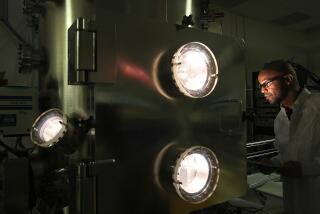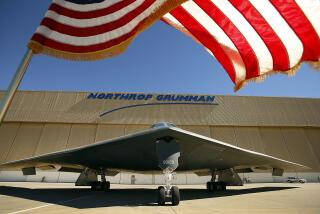Hughes Aircraft plant has rich legacy in defense industry
- Share via
It’s best known as the place where Howard Hughes built the massive Spruce Goose. But the old Hughes Aircraft Co. plant in Playa Vista played a far greater role as a foundry for some of the nation’s more important weapon systems.
The 1,300-acre site was dubbed a national resource by the federal government because it developed technologically advanced weapons projects that the Pentagon believed no other defense contractors were capable of tackling.
During the Cold War, the former Soviet Union even considered it one of the first targets of its nuclear-tipped intercontinental ballistic missiles.
“People will always remember the Spruce Goose because it was such a monumental undertaking,” said Loren Thompson, a military policy analyst for the Lexington Institute, a think tank in Arlington, Va. “But that was just the beginning of an amazing aerospace empire.”
At its height about 30,000 people worked at the 11-building site where engineers developed the first radar-guided air-to-air missile, the first functional laser and the first geosynchronous communications satellite.
Later, engineers there spearheaded the commercializing of satellites and created XM Radio and DirecTV.
“We had an enormous group of extremely talented people who could dream up technologies and then go on to develop them. We fed on one another,” said D. Kenneth Richardson, a former Hughes president who is writing a book about the company, “Hughes After Howard.”
The key to Hughes’ success was attracting some of the nation’s most talented young engineers and scientists, Richardson said. It was a tradition that was started in the early 1950s when the electronics division — responsible for developing the air-to-air missile, fired from an aircraft at a target in the air, that revolutionized aerial combat — was headed by Simon Ramo and Dean Wooldridge, two graduates of the California Institute of Technology in Pasadena.
The pair grew the electronics division from a handful of employees to a workforce of 3,000 before co-founding a rival company in 1953 that would later become TRW Inc., which in 2002 was acquired by Century City-based Northrop Grumman Corp.
Hughes grew rapidly with the onset of the Korean War and then the Vietnam War. At the height of the Cold War, Hughes had more than 80,000 employees, most of them in California, making it the state’s largest industrial employer.
Howard Hughes, the eccentric billionaire who founded his namesake company in 1932, turned over the business to a medical institute he created in 1954.
In 1985, Hughes Aircraft was sold to General Motors Corp. and the automaker began dismantling the headquarters in Playa Vista, a process that ended in 2003.
Although there are no longer manufacturing facilities in Southern California that bear the Hughes name, dozens of buildings are vestiges of the company’s past. Boeing Co.’s sprawling 1-million-square-foot satellite manufacturing facility and Raytheon Co.’s 1.7-million-square-foot electronics enclave, both in El Segundo, were once pieces of the Hughes defense empire.
“It’s a tragedy that the name of the company has been lost to history,” said Malcolm R. Currie, Hughes’ chief executive from 1988 to 1992. “But if you look close enough, you can see that the company’s fingerprints are on some of the great technological breakthroughs of the last 50 years. To me, that’s the company’s legacy.”
More to Read
Inside the business of entertainment
The Wide Shot brings you news, analysis and insights on everything from streaming wars to production — and what it all means for the future.
You may occasionally receive promotional content from the Los Angeles Times.











